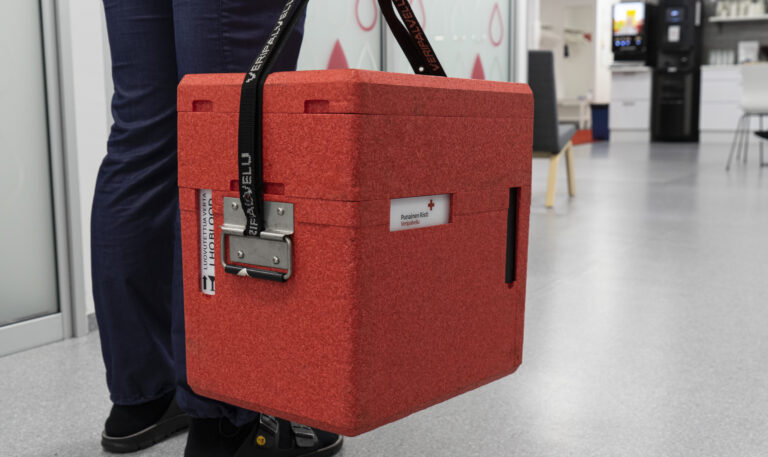Who needs donated blood?
Lives are saved with blood products. Without blood transfusions, major surgeries couldn’t be performed. Blood is also needed for accident victims, mothers giving birth, and premature babies.

Did you know that someone receives a blood transfusion every 10 minutes? Blood products – red blood cells, platelets, or plasma – are given to about 40,000 patients in Finland every year. Artificial blood is not in sight.
Who receives blood?
Every day, hospitals use hundreds of bags of blood products.
About two-thirds of blood transfusions are planned in advance. Donated blood is needed for major surgeries—such as heart or cancer operations—and for patients with severe anemia. Blood products are also critical for cancer patients.
Blood is also given to mothers after childbirth and to accident victims who have lost large amounts of blood.
A patient suffering from massive bleeding may require tens of bags of red blood cells, platelets, and plasma at once. If the patient’s blood type cannot be determined in time, transfusion is started with O-negative blood, which is compatible with all blood types. As soon as the blood group is known, transfusion continues with type-matched blood.
On average, one patient receives six units of blood products. Some people need regular transfusions throughout their lives—relying on countless blood donors.
Plasma separated from whole blood is also used to make medicines to treat bleeding disorders and clotting factor deficiencies, and to help burn or shock patients.
One donation helps many
Donated blood is separated into three components: red blood cells, platelets, and plasma. This means that a single donation can help several people.
Red Blood Cells
Function: Carry oxygen
Given to:
-
Patients undergoing surgery (e.g., heart, hip)
-
Accident victims and mothers after childbirth
-
People with anemia (low hemoglobin)
-
Patients with blood disorders (e.g., thalassemia, sickle cell anemia, aplastic anemia)
Red blood cells are used when someone has lost significant blood—for example, in accidents, major surgeries, or childbirth. Blood loss can quickly reduce the body’s ability to carry oxygen.
Red blood cells can even be transfused into fetuses and premature babies. Some patients with chronic blood disorders may receive hundreds of red cell units over the years.
Platelets (Thrombocytes)
Function: Help blood clot and stop bleeding
Given to:
-
Cancer patients
-
Accident victims and mothers after childbirth
Platelets are needed when the body doesn’t produce enough, or they don’t work properly. For example, chemotherapy in leukemia patients also damages healthy blood cells. Platelets are often needed after stem cell transplantation or during severe bleeding.
Plasma
Function: Contains clotting factors, proteins (such as albumin), antibodies, and hormones; helps maintain fluid balance
Plasma products are given to:
-
Burn patients
-
Patients with severe bleeding (e.g., trauma victims, during major surgeries)
-
People with clotting disorders, such as hemophilia
Plasma-derived medicines are given to: -
People with immune deficiencies
-
Those with autoimmune diseases
Plasma donated in Finland is used to manufacture plasma-derived medicines such as immunoglobulins (which help fight infections and regulate the immune system) and clotting factors for those with bleeding disorders.
When is blood given?
Blood is only transfused when absolutely necessary—for example, to save a life or correct a critical situation.
There is no single threshold—like a specific hemoglobin level—for giving red blood cells. The doctor assesses each patient’s condition individually. Blood transfusions are not routine procedures; they always carry a small risk of infection or adverse reaction.
Can you help?
Blood products cannot be replaced by medication—donors are essential. Patients in Finland need the help of 600–700 blood donors every day. All blood groups are needed.
Blood products have a short shelf life. Red blood cells must be used within five weeks, and platelets within one week of donation. The need can change quickly: for example, a liver transplant patient might require dozens of blood products at once.
Thank you for choosing to help!
If you’re not able to donate yourself, please spread the word about how important blood donation is.


